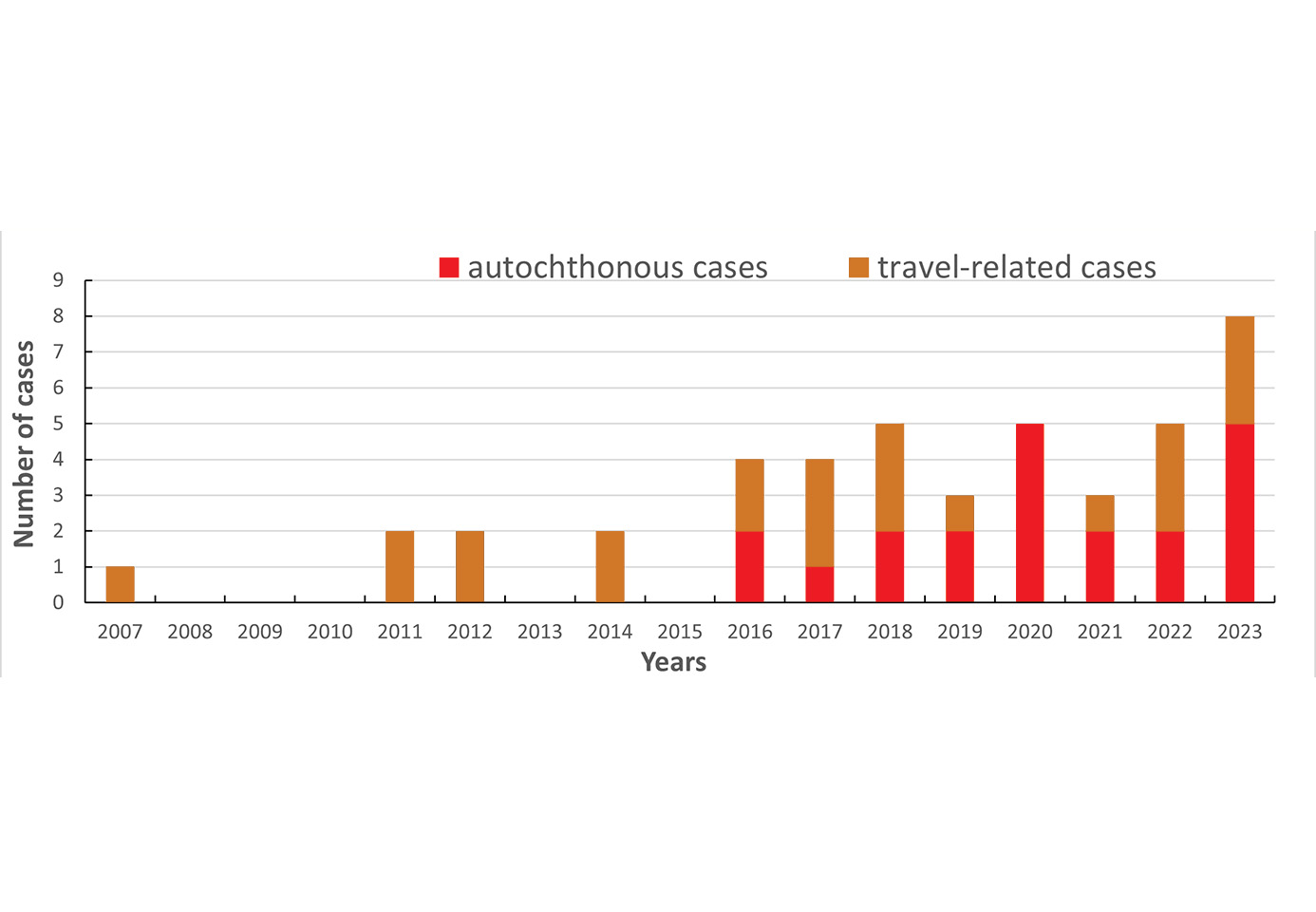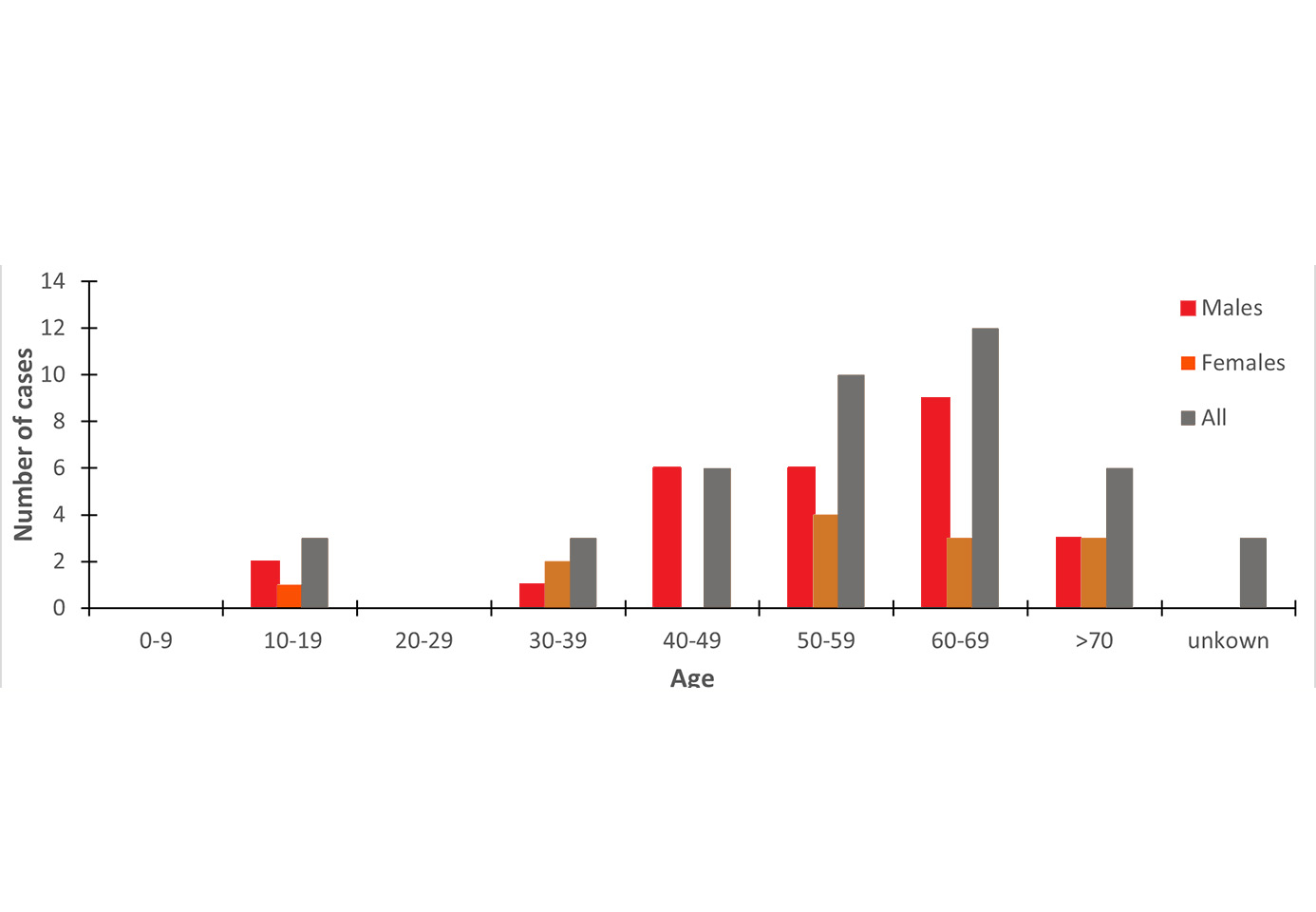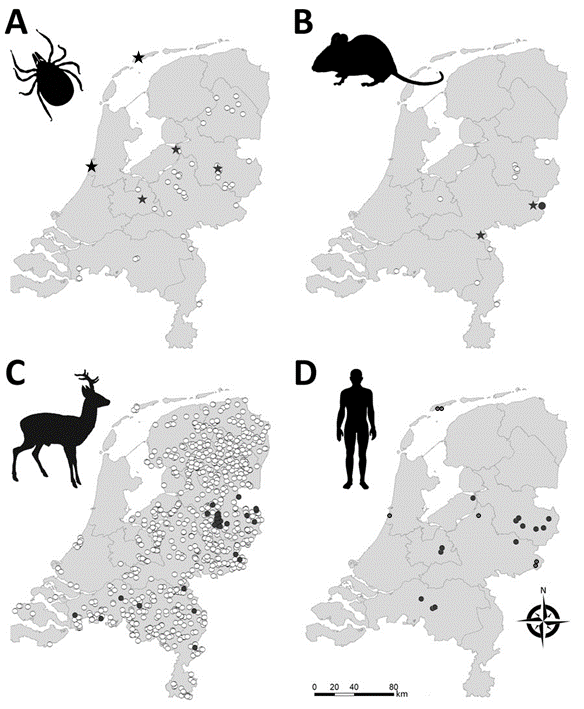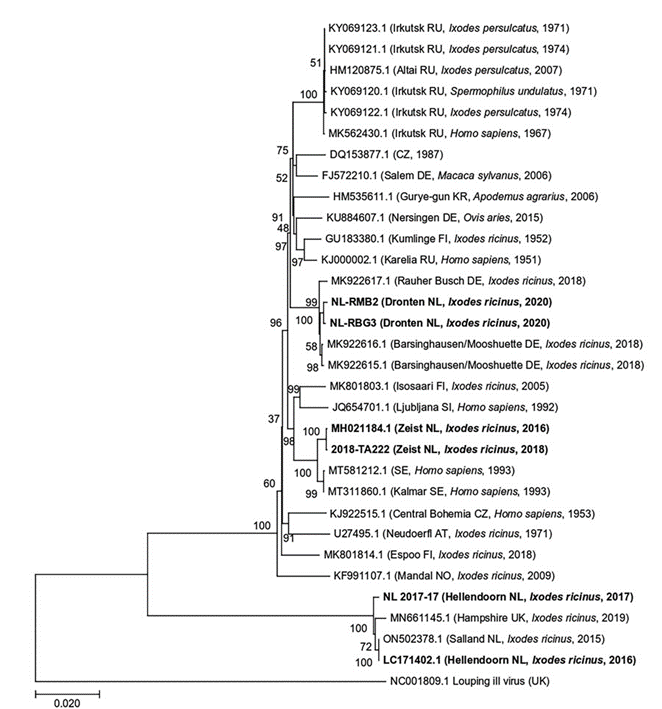Johan H.J. Reimerink, Hein Sprong, Margriet Harms and Chantal B.E.M. Reusken
ECDC risk status: endemic
(data as of end 2023)
History and current situation
Until 2015, tick-borne encephalitis virus (TBEV) was presumed not to be endemic in the Netherlands.1,2 Consequently, the number of diagnostic requests for detection of tick-borne encephalitis (TBE) infection has been low. Between 2006 and 2015, the laboratory of the Netherlands Centre for Infectious Disease Control (CIb), 1 of the 2 laboratories that performed TBEV diagnostics in the Netherlands at the time, received an average of 20 (range 12–27) requests for TBEV diagnostics per year. In the same period, TBE was diagnosed in 7 Dutch patients. All cases were considered to be travel-related. Indeed, 6 out of 7 patients reported that they had recently travelled to TBEV-endemic countries such as Austria (4), Germany (1), and Sweden (1).
In 2015, however, six of 297 (2%) roe deer sera, collected in 2010, were found serologically positive for TBEV-infection.2,3 Five of 6 sera were collected at the national park ‘Sallandse heuvelrug’ in the province of Overijssel, in the east of the Netherlands. The other TBEV-positive roe deer serum was collected in the south of the Netherlands, in the province of Noord-Brabant. Based on these findings, I. ricinus ticks were collected for screening for the presence of TBEV at the ‘Sallandse heuvelrug’ in 2015. From the approximately 1,460 ticks collected in 2015, one pool of nymphs (0.09%) and one pool of female adult ticks (0.33%) were RT-PCR-positive for TBEV.3,4 Sequencing of the viral genome revealed that the virus grouped with the European (Western) subtype but was genetically distinct from all known Western European TBEV strains. Based on the near complete genome, the ‘Salland’ strain diverged from currently known TBEV-Eu strains by 9% on nucleotide and 2% on amino acid level, respectively.
In 2016, soon after the Netherlands Centre for Infectious Disease Control raised general awareness of the presence of TBEV in the Netherlands, the first 2 autochthonous TBE cases were reported.5,6 Both patients were positive for TBEV-specific antibodies by ELISA and virus neutralization test. The first patient most likely acquired TBEV when hiking at the national park ‘Utrechtse Heuvelrug’2,5 located in the center of the Netherlands (Figure 3). A tick collected from this patient was RT-PCR-positive for TBEV RNA. Interestingly, the virus strain from this tick was genetically similar to known Western European TBEV strains and differed considerably from the Salland strain (9% on nucleotide level, 2% on amino acid level). The second patient lived near the national park Sallandse heuvelrug and frequently visited this park. Moreover, twenty additional autochthonous human cases have been reported since (till December 2023). From the five autochthonous cases reported in 2023, three patients were from two of the endemic regions: Salland-region and the island of Terschelling. The other patients were reported outside the known TBEV loci: one in the province of Gelderland (Ermelo), and one in Noord-Holland (Bloemendaal) (Figure 3). The presence of the TBEV on Terschelling and in Bloemendaal could be confirmed by the detection of viral RNA in questing ticks. Additionally, three travel-associated TBEV infections were diagnosed in 2023 and most probably infected in Italy, Sweden and Austria.
The number of laboratories implementing routine TBEV diagnostics stagnates at five with virus neutralization tests implemented at the two National Reference laboratories for arboviruses. Despite the general availability of routine diagnostics in the Netherlands the number of diagnosed cases is still low.
A One-Health approach is conducted in The Netherlands, where ticks will be collected and tested from locations outside endemic areas, where TBE-patients were when they contracted a tick bite. With this approach we could confirm the presence of the virus near Bloemendaal and on Terschelling. Phylogenetic analyses indicates that at least 5 different variants of the TBEV-Eu subtype circulate in the Netherlands, suggesting multiple independent introductions. Combined with data on human cases and from roe deer, our impression is that the distribution of TBEV in the Netherlands is more widespread than previously thought.11
As it is not mandatory to report TBEV in the Netherlands,8 the exact number of requests for TBEV diagnostics and confirmed cases per year is currently not available.
In summary, in 2016, the first autochthonous TBE cases were reported in the Netherlands. Since then autochthonous cases have been recognized mainly in or close to the two known foci of presence. In 2020 we saw three TBE cases outside the known endemic regions which might be indicative of an expanding presence. However, TBEV was likely already present in these areas before 2020 according to the roe dear seroprevalence study in 2017. Awareness for TBEV is increasing in the Netherlands as reflected in the increasing number of labs that implemented diagnostics and the increase in requests for TBEV diagnostics at the CIb. Two different Western European TBEV strains have been detected in the Netherlands. Based on the fact that two autochthonous cases were infected near national park ‘Sallandse heuvelrug’, it is highly likely that the divergent ‘Salland’ strain found in this area can cause disease in humans, but this remains to be confirmed.
Overview of TBE in the Netherlands
| Table 1: Virus, vector, transmission of TBE in Netherlands | |
|---|---|
| Viral subtypes, distribution | TBEV-EU (Utrechtse Heuvelrug)5,6
TBEV-EU “Salland” (Sallandse Heuvelrug)3 |
| Reservoir animals | Unknown(Roe deer were found to be sentinels and are likely dead-end hosts)3 |
| Infected tick species (%) | I. ricinus3-5 |
| Dairy product transmission | No information available |
| Table 2: TBE reporting and vaccine prevention in Netherlands | |
|---|---|
| Mandatory TBE reporting | It is not mandatory to report TBE in the Netherlands8 |
| Other TBE-surveillance | – |
| Special clinical features | No information available |
| Available vaccines | FSME-Immun® andFSME-Immun® Junior8 |
| Vaccination recommendations and reimbursement | Upon travel to TBEV-endemic areas vaccination can be considered8 |
| Vaccine uptake by age group/ risk group/ general population | No information available |
| Name, address/website of TBE National Reference Center | – |
Figure 1: Burden of TBE in the Netherlands over time

| Year | Number of cases |
|---|---|
| 2006 | 0 |
| 2007 | 1 (1 travel-related) |
| 2008 | 0 |
| 2009 | 0 |
| 2010 | 0 |
| 2011 | 2 (2 travel-related) |
| 2012 | 2 (2 travel-related) |
| 2013 | 0 |
| 2014 | 2 (2 travel-related) |
| 2015 | 0 |
| 2016 | 4 (2 travel-related) |
| 2017 | 4 (3 travel-related) |
| 2018 | 5 (3 travel-related) |
| 2019 | 3 (1 travel-related) |
| 2020 | 5 (0 travel-related) |
| 2021 | 3 (1 travel-related) |
| 2022 | 5 (3 travel-related) |
| 2023 | 8 (3 travel-related) |
Figure 2: Age and gender distribution of TBE in the Netherlands

| Age group (years) | Males | Females | All |
|---|---|---|---|
| 0-9 | 0 | 0 | 0 |
| 10-19 | 2 | 1 | 3 |
| 20-29 | 0 | 0 | 0 |
| 30-39 | 1 | 2 | 3 |
| 40-49 | 6 | 0 | 6 |
| 50-59 | 6 | 4 | 10 |
| 60-69 | 9 | 3 | 12 |
| >70 | 3 | 3 | 6 |
| Unknown | 3 |
Figure 3: Geographic distribution of tick-borne encephalitis virus (TBEV) in the Netherlands based on sampling of ticks (A), rodents (B), roe deer (C), and reported human (D) tick-borne encephalitis cases
Stars indicate TBEV RNA–positive tick pools or rodent samples. Closed circles indicate serum samples that tested positive in TBEV serum neutralization tests. White circles indicate negative test results. Figure is partially based on (Esser et al.)
Figure 4: Maximum-likelihood phylogenetic tree of polyprotein sequences obtained from tick-borne encephalitis virus RNA–positive Ixodes ricinus ticks collected from 3 locations in the Netherlands during 2016–2020

Additional published sequences obtained from GenBank are included for reference.
Louping ill virus is used as the outgroup. Sample ID or GenBank accession numbers are indicated for each sequence, with location in brackets (if known) and country code, original isolation source, and collection year of each sample. Numbers next to each branch indicate the percentage of trees resulting from bootstrapping on the basis of 1,000 pseudoreplicate datasets for which the associated taxa clustered together.
Scale bar represents the percentage of genetic variation along tree branches.
Contact
Johan H.J. Reimerink,
johan.reimerink@rivm.nl
Authors
Johan H.J. Reimerink, Hein Sprong, Margriet Harms and Chantal B.E.M. Reusken
Citation
Johan H.J. Reimerink, Hein Sprong, Margriet Harms and Chantal B.E.M. Reusken. Chapter 13. In: Dobler G, Erber W, Bröker M, Chitimia-Dobler L, Schmitt HJ, eds. The TBE Book. 7th ed. Singapore: Global Health Press; 2024. doi:10.33442/26613980_13-23-7
References
- Reusken C, Reimerink J, Verduin C, Sabbe L, Cleton N, Koopmans M. Case report: tick-borne encephalitis in two Dutch travellers returning from Austria, Netherlands, July and August 2011. Euro Surveill. 2011;16(44).
- Schimmer B, Reimerink JH, Hira V, et al. First autochthonous cases of tick-borne encephalitis detected in the Netherlands, July 2016.
- Jahfari S, de Vries A, Rijks JM, et al. Tick-Borne Encephalitis Virus in Ticks and Roe Deer, the Netherlands. Emerg Infect Dis. 2017;23(6):1028-1030. doi:10.3201/eid2306.161247
- [Tick-borne encephalitis virus found in Dutch ticks]. Signaleringsoverleg 26/2016. Bilthoven: Rijksinstituut voor volksgezondheid en milieu; 2016.
- de Graaf JA, Reimerink JH, Voorn GP, et al. First human case of tick-borne encephalitis virus infection acquired in the Netherlands, July 2016 [published correction appears in Euro Surveill. 2016 Aug 25;21(34):]. Euro Surveill. 2016;21(33):30318. doi:10.2807/1560-7917.ES.2016.21.33.30318
- Hira V, de Graaf JA, Rockx B; authors of the original article. Author’s reply: The first tick-borne encephalitis case in the Netherlands: reflections and a note of caution. Euro Surveill. 2016;21(39):30356. doi:10.2807/1560-7917.ES.2016.21.39.30356
- Rijks JM, Montizaan MGE, Bakker N, de Vries A, Van Gucht S, Swaan C, et al. Tick-borne Encephalitis Virus Antibodies in Roe Deer, the Netherlands. Emerg Infect Dis. 2019;25(2). doi:10.3201/eid2502.181386
- Dekker M, Laverman GD, de Vries A, Reimerink J, Geeraedts F. Emergence of tick-borne encephalitis (TBE) in the Netherlands. Ticks Tick Borne Dis. 2019 Jan;10(1):176-179. doi:10.1016/j.ttbdis.2018.10.008
- Geeraedts F, van der Kroft E, Reimerink J. First paediatric case of autochthonous tick-borne encephalitis in the Netherlands, 2018. New Microbes New Infect. 2019;32:100603. Published 2019 Sep 19. doi:10.1016/j.nmni.2019.100603
- LCI-richtlijn Tekenencephalitis: RIVM; 2016. Accessed 17 March, 2024. http://www.rivm.nl/Documenten_en_publicaties/Professioneel_Praktisch/Richtlijnen/Infectieziekten/LCI_richtlijnen/LCI_richtlijn_Tekenencefalitis.
- Esser HJ, Lim SM, de Vries A, et al. Continued Circulation of Tick-Borne Encephalitis Virus Variants and Detection of Novel Transmission Foci, the Netherlands. Emerg Infect Dis. 2022;28(12):2416-2424. doi:10.3201/eid2812.220552